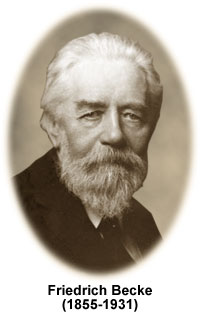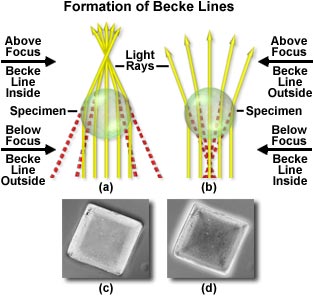Friedrich Johann Karl Becke
(1855-1931)

Friedrich Johann Karl Becke was an Austrian geologist, mineralogist and petrologist from the University of Prague, who developed a method for determining the relationship between light refraction and refractive index differences observed in microscopic specimens. The phenomenon, which is now referred to as the formation of Becke lines, has been named for him. Becke also conducted important work on metamorphic rock recrystallization, and later contributed to the development of a descriptive terminology and classification of mineral assemblages in metamorphic rocks.
In transmitted-light microscopy, the Becke line test is a comparative test utilized to determine the approximate refractive index of a mineral. Utilizing plane-polarized light, the substage iris diaphragm is partly closed to accentuate grain boundaries, resulting in the appearance of a thin line of light, the Becke line, which either surrounds the specimen or is visible within the specimen boundaries. If the microscope objective is then moved up or down, away from the position of focus, the Becke line will move into the medium having a higher refractive index. In general, a medium suitable for determination of refractive indices (and to observe Becke lines) is either an adjacent mineral of known refractive index, an immersion oil, or a mounting medium such as Canada balsam.
Born on New Year's Eve, 1855 in Prague (then part of the Austro-Hungarian Empire), Becke moved to Vienna, where he studied under Gustav Tschermak and was appointed chairman of mineralogy at the University of Vienna (1898). Many years later, he was made rector (1921), and died ten years after that in the summer of 1931. Becke presented a landmark paper (1903) on the composition and texture of the crystalline schists to the International Geological Congress, which represented the first comprehensive theory on metamorphic rocks. His subsequent work on retrogressive metamorphism led to a more thorough understanding of many ancient mountain belts, and he served as editor of the journal Mineralogische und Petrographische Mitteilungen (Mineralogical and Petrographical Notices) after 1899.
The Austrian Mineralogical Society (founded in 1901) awards the Becke Medal, a tribute to the famous mineralogist and their second president, to outstanding scientists for their significant contributions to mineralogy, crystallography, petrology, and other disciplines in geophysics and geochemistry. Becke was a member of the Berlin-Brandenburg Academy of Sciences and Humanities (then the Prussian Academy of Sciences and Humanities) and an honorary member of the Geological Society of Sweden (1916).
Becke Lines - Are defined as the broad, dark or bright lines (due to refraction and/or diffraction) formed in the image at the boundary between media of different optical path lengths. They move in the direction of the longer optical path when the distance between the objective and the object is increased. The Becke line disappears in the region of the object that lies in exact focus.

Formation of Becke lines is illustrated in the figure above. In (a) the transparent specimen has a higher refractive index than the surrounding medium. When the objective is raised above focus a bright Becke line appears inside the specimen, but the Becke line appears to enlarge and surrounds the specimen when the objective is moved below the focus point. If the specimen has a lower refractive index than that of the medium (b), the situation is reversed and raising the objective above focus produces a bright Becke line surrounding the specimen.
Grains and fibers are often convex in shape and either diverge or converge light, depending upon whether their refractive index is lower or higher than the surrounding medium (usually oil). In either case, light is converged into the medium having a higher refractive index. A specimen having parallel faces will produce Becke lines at the boundaries having the higher refractive index by total internal reflection.
Reliable Becke lines may be obtained with medium-power objectives (10x through 50x) with numerical apertures ranging from 0.5 to around 0.7. The condenser aperture should be reduced until strong Becke lines are observed through the microscope eyepieces, with increasingly smaller aperture sizes being employed as the refractive index difference between the specimen and medium is narrowed. Adjustment of the condenser aperture should be undertaken while viewing the specimen and progressively closing the diaphragm until good Becke lines are observed.
Note: This phenomenon is used to recognize relative differences in refractive index of two adjacent media, for example, a particle and the surrounding mounting medium. When the refractive indices are matched the Becke line disappears.
